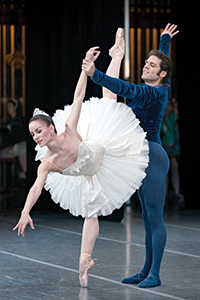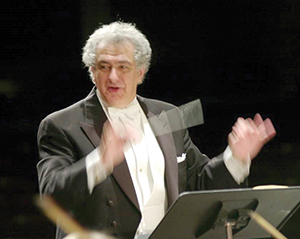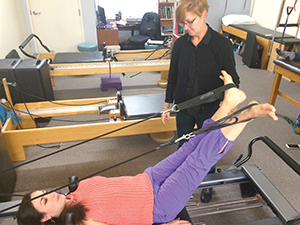By RENEE STOVSKY
Whether it's conducting Chopin's "Piano Sonata No. 2," executing an arabesque in Tchaikovsky's "Swan Lake," or rehearsing the famous fencing scene in Shakespeare's "Hamlet," performing artists tend to get hurt. A lot.
Orchestra maestros are prone to back problems and rotator cuff injuries. Ballerinas suffer sprained ankles and anterior cruciate ligament, or ACL, tears. Dramatic actors can experience neck spasms, hamstring pulls and more.
And unlike the rest of us, they don't have the luxury of time to heal their wounds. They need to recover as quickly as possible so they can return to the stage — and their livelihoods.

Cincinnati Ballet Principal Dancer Sarah Hairston and Senior Soloist Zack Grubbs perform "Symphony in C." Hairston relied on Mercy Health's Performing Arts Medicine program to speed her recovery from dance injuries. Both dancers retired in September and assumed leadership roles with the ballet's Otto M. Budig Academy. (Photo by: Peter Mueller)
Curtain's up
In Cincinnati, dancers, musicians and thespians have learned to count on Mercy Health's Performing Arts Medicine program for treatment and preventive care.
The program began in 2013 when Mercy acquired the downtown practice of Wellington Orthopaedics and Sports Medicine, a local orthopedics/sports medicine clinic. It now serves about 50 clients a week — the great majority of them dancers. The clinic offers physical therapy, Pilates, electrical stimulation and massage to help them either recover from or avoid injuries.
Staffed by supervisor Jacqui Haas, a former ballet dancer turned athletic trainer and author of Dance Anatomy, a Human Kinetics publication; Kelly Jo Trimble, another athletic trainer; Katie Faris, a physical therapist; and a medical resident, the program is committed to the specialized assessment and management of physical problems artists of all kinds endure.
"Dancers routinely perform moves that require both strength and an extreme range of motion. Musicians often perform in awkward body positions that can cause stress on joints, muscles and ligaments," says Haas. "The demands of a job in the performing arts definitely can lead to physical challenges. And losing rehearsal or performance time due to injury is both emotionally and financially challenging."
Artsy neighborhood
That's why the clinic, located in the same building as the Cincinnati Ballet and its Otto M. Budig Academy, is committed not only to assessing and treating injuries and referring clients to physicians when needed, but also to conditioning them to maintain their general health and wellness.
"More than 65 percent of the injuries we see are due to overuse, rather than to acute complaints," says Haas. "We try to evaluate a patient's technique to see why he or she has gotten hurt. That way we can not only repair damage, but hopefully prevent it."
The clinic's location is, of course, ideal for the ballet company and the 500 students who attend its ballet academy, but it is also quite accessible to the city's other arts groups, from the Cincinnati Symphony Orchestra to the Ensemble Theatre, Playhouse in the Park, School for Creative and Performing Arts, and the University of Cincinnati preparatory arts program. In addition, dancers in touring Broadway shows that perform at the Aronoff Center for the Arts often access the clinic for injuries they suffer on the road. And downtown office workers and residents in need of physical therapy use the clinic as well.
Clinic personnel also go off-site to offer postural assessments for musicians, present injury prevention workshops and visit local ballet studios for pre-clinic screenings before young dancers begin to dance on pointe, balancing their weight on their toe tips.
"Everyone's anatomy is different, so it's important to review each artist's movements and individualize help," says Haas.
Musician athletes
Carmon DeLeone, 74, has spent 52 years as a professional conductor. Currently he is music director of the Cincinnati Ballet, Ohio's Middletown Symphony Orchestra and conductor laureate of the Illinois Philharmonic Orchestra. He also served a 12-year tenure as assistant and later resident conductor of the Cincinnati Symphony Orchestra.
So it's not surprising that he's suffered a few injuries along the way.

Carmon DeLeone credits Mercy Health's rehabilitation for the range of motion he recovered following rotator cuff surgery.
"Conducting is physically strenuous and mentally stressful. It also needs to be athletically elegant," he says. "A maestro tends to get lots of upper body exercise, with all that arm waving, but leg strength is important for the long periods of standing as well."
DeLeone has had two surgeries during his career, first for a herniated disc and more recently for a rotator cuff injury.
"The rotator cuff surgery was a difficult recovery because of all the action your arm needs to do; the shoulder needs to be very flexible in every direction," he recalls.
After wearing a constrictive sling for four to six weeks post-op, he remembers a four-month rehabilitation stint with Haas that involved lots of heat, ice, electrical stimulation and physical therapy.
"There was lots of pain involved until I could loosen the muscle up again," he says. "It took a year before it was really out of my memory."
Cross training for musicians
DeLeone credits Haas with his successful recovery, and adds that he has sent many of his orchestra members to the Performing Arts Medicine program for evaluation and treatment as well.
"Carpal tunnel is common among musicians — especially pianists, string players and flutists — because of the repetitive action of fingers and hands. Drummers experience lots of back problems because they are always packing up heavy equipment," he says. "And violinists are particularly prone to injuries because of the contorted position in which they hold their instruments in their necks, wrap their elbows forward and have their hands lying over their fingerboards."
These days, DeLeone says he is cognizant of the need to focus on his legs to maintain his conducting abilities.
"I admit I'm pretty chairbound, so I have a recumbent exercise bike to strengthen my legs," he says. "I've also done some Pilates at the clinic, though not as regularly as I should. But I know if I get in any trouble, I can ring up Jacqui for help."
Accelerated recovery
Sarah Hairston, 35, a principal dancer for 15 years with the Cincinnati Ballet before her recent retirement to become director of its ballet academy, calls herself a "regular fixture" at the clinic.

Under the watchful eye of athletic trainer Jacqui Haas, right, ballerina Sarah Hairston uses the Pilates reformer to work on turnouts, flexibility and core strength at Mercy Health's Performing Arts Medicine practice in Cincinnati. (Photo by: Peter Mueller)
"Dancers always have injuries — men are prone to back and shoulder injuries because of the lifting they do, and women typically have more ankle and foot injuries," says Hairston.
"But before the Mercy Performing Arts program located here, we couldn't just come downstairs, say 'I think I've done something to my ankle,' and have someone assess us on-site and take care of things in a timely fashion," she says. "Now we have different therapies that are more easily accessible and professional staff that can work with us so that we don't reinjure ourselves."
Hairston herself has suffered sprained ankles, bulging discs in her back, meniscus tears in her knees, hip tears, serious neck issues and, recently, a serious ACL tear.
"An ACL tear usually requires 18 to 24 months of rehab for a ballet dancer," says Hairston. "But because I was able to work with the trainers here every day, eight hours a day, doing everything from weight lifting and Pilates to massage, and jumping on trampolines and jumping off boxes, I was able to recover in six months. That's pretty amazing."
Haas credits that kind of success to the commitment her clinic has to treat the "whole dancer," not just the "injured leg."
Extending careers
"With ACL surgery, a regular patient literally has to learn how to walk again without dragging the leg. But a dancer needs to learn how to dance — and kick her leg over her head if needed," Haas says. "We make certain to work out every other body part — core, arms, etcetera — to keep the dancer in shape while the leg is healing."
That kind of intense therapy — the kind offered by the Mercy Performing Arts program — is what helps performing artists maintain their flexibility, stamina and strength.
"The careers of many performing artists are short, due to physical demands and injuries," she says. "We are here to help them maintain their health and extend those careers as long as possible."
Copyright © 2016 by the Catholic Health Association
of the United States
For reprint permission, contact Betty Crosby or call (314) 253-3477.